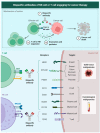Bispecific Antibodies in Cancer Immunotherapy: A Novel Response to an Old Question
- PMID: 35745815
- PMCID: PMC9229626
- DOI: 10.3390/pharmaceutics14061243
Bispecific Antibodies in Cancer Immunotherapy: A Novel Response to an Old Question
Abstract
Immunotherapy has redefined the treatment of cancer patients and it is constantly generating new advances and approaches. Among the multiple options of immunotherapy, bispecific antibodies (bsAbs) represent a novel thoughtful approach. These drugs integrate the action of the immune system in a strategy to redirect the activation of innate and adaptive immunity toward specific antigens and specific tumor locations. Here we discussed some basic aspects of the design and function of bsAbs, their main challenges and the state-of-the-art of these molecules in the treatment of hematological and solid malignancies and future perspectives.
Keywords: bispecific antibodies; cancer therapy; immune restoration; immunotherapy.
Conflict of interest statement
Andrés F. Cardona discloses financial research support from Merck Sharp & Dohme, Boehringer Ingelheim, Roche, Bristol-Myers Squibb and The Foundation for Clinical and Applied Cancer Research—FICMAC. Additionally, he was linked with and received honoraria as advisor, participate in speakers’ bureau and gave expert testimony to Merck Sharp & Dohme, Boehringer Ingelheim, Roche, Bristol-Myers Squibb, Pfizer, Novartis, Celldex Therapeutics, Foundation Medicine, Eli Lilly and Foundation for Clinical and Applied Cancer Research—FICMAC. Oscar Arrieta reports personal fees from Pfizer, grants and personal fees from Astra zeneca, grants and personal fees from Boehringer Ingelheim, personal fees from Lilly, personal fees from Merck, personal fees from Bristol Myers Squibb, grants and personal fees from Roche, outside the submitted work. Christian Rolfo is a current employee of the Center for Thoracic Oncology at Tisch Cancer Institute, Mount Sinai Health System and Icahn School of Medicine. He reports receiving supported research funding from Lung Cancer Research Foundation-Pfizer; receiving non-financial research support from Guardant Health; providing advisory services to ARCHER, Inivata, EMD Serono, BMS, Novartis, Boston Pharmaceuticals, Pfizer, Mirati, and Eisai; providing speaker services to MSD, AstraZeneca, Roche, and Guardant Health; and participating in the Safety Monitoring Board for EMD Serono.
Figures


References
Publication types
LinkOut - more resources
Full Text Sources
Other Literature Sources

